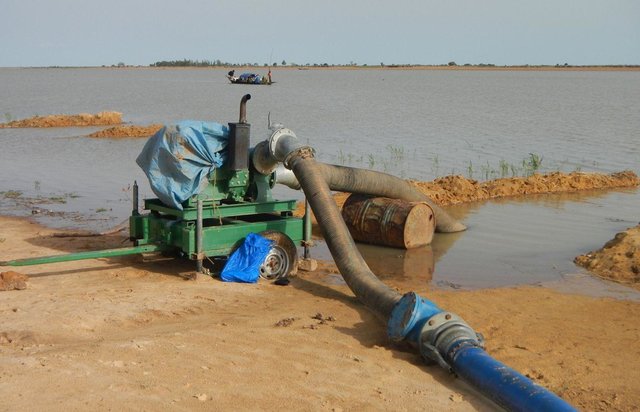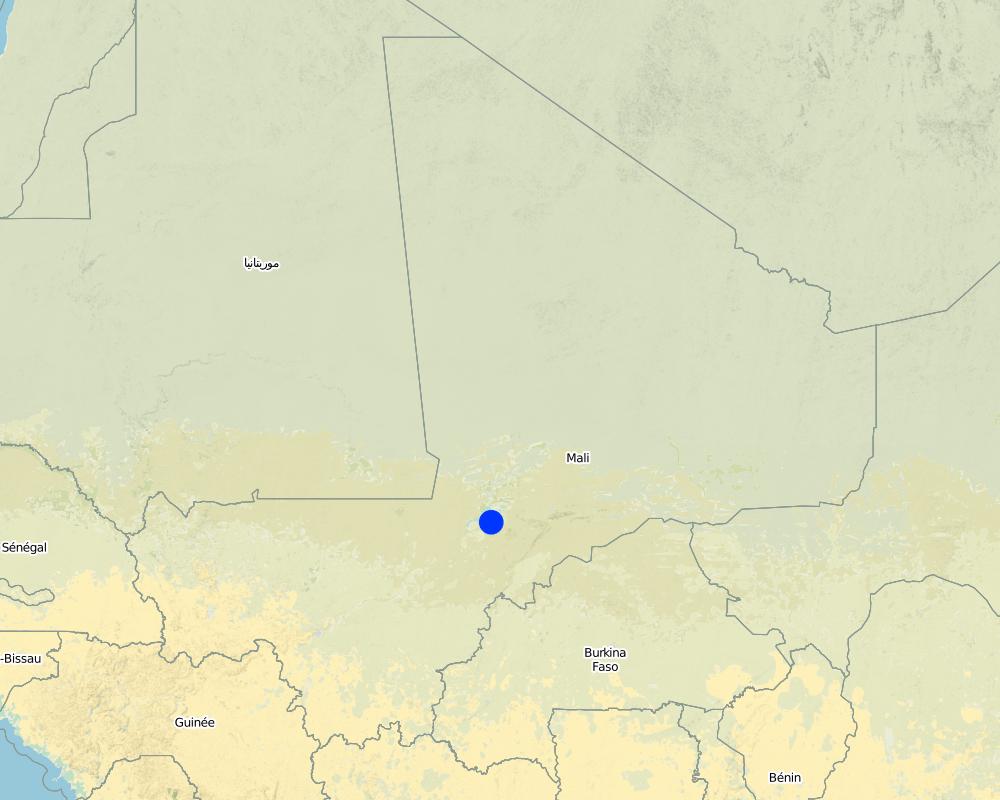Participatory approach to small-scale irrigation [Mali]
- Creation:
- Update:
- Compiler: Dieter Nill
- Editor: –
- Reviewer: Laura Ebneter
Approche participative dans l’irrigation de proximité
approaches_2513 - Mali
View sections
Expand all Collapse all1. General information
1.2 Contact details of resource persons and institutions involved in the assessment and documentation of the Approach
SLM specialist:
Kone Mamadou Gallo
gallokone@yahoo.fr
IPRO-DB Bélédougou
Mali
SLM specialist:
Schneider Ralf
ralf_schneider5@hotmail.com
IPRO-DB Bélédougou
Mali
SLM specialist:
Ouologuem Abass
ouologuemabass@yahoo.fr
IPRO-DB Bélédougou
Mali
Name of project which facilitated the documentation/ evaluation of the Approach (if relevant)
Le Projet Irrigation de Proximité au Pays Dogon et dans le Bélédougou, Mali (IPRO-DB)Name of the institution(s) which facilitated the documentation/ evaluation of the Approach (if relevant)
Deutsche Gesellschaft für Internationale Zusammenarbeit (GIZ) GmbH (GIZ) - Germany1.3 Conditions regarding the use of data documented through WOCAT
When were the data compiled (in the field)?
01/07/2012
The compiler and key resource person(s) accept the conditions regarding the use of data documented through WOCAT:
Ja
1.4 Reference(s) to Questionnaire(s) on SLM Technologies

Irrigation using a Californian network [Mali]
A micro-irrigation system to use water more efficiently and increase yields
- Compiler: Dieter Nill

Village irrigation schemes developed using the PMN/IPRODI approach [Mali]
Village irrigation schemes (VISs) help to control the water supply and significantly increase yields.
- Compiler: Dieter Nill
2. Description of the SLM Approach
2.1 Short description of the Approach
The participatory approach to small-scale irrigation ensures skills and expertise are transferred to scheme beneficiaries and other stakeholders.
2.2 Detailed description of the Approach
Detailed description of the Approach:
The participatory approach to small-scale irrigation (SI) ensures skills and expertise are transferred to scheme beneficiaries and other stakeholders. This enhances the value of investments and the sustainability of installations.
Direct beneficiaries (villagers) and indirect beneficiaries (technical services, communes) are involved before, during and after the installation of irrigation systems in order to ensure the sustainability of the schemes and a long-term return on investment.
Firstly, all the actors involved in the schemes are identified. Beneficiaries’ concerns are taken into account and the participation of relevant actors is ensured throughout the process. The following factors are essential when applying this approach: 1) the commitment of beneficiaries to engage in the project approach; 2) an explicit request made by beneficiaries for the scheme in question; 3) an agreement to relay the content of meetings to all beneficiaries; 4) an awareness of potentially significant constraints such as property issues, a lack of villagers available to provide labour, and the payment of financial contributions.
The participatory approach enhances the sustainability of investments, while the cost of participation remains low. The prevention and management of conflicts, the commitment of beneficiaries to schemes and the uptake of construction and management techniques by beneficiaries are all factors that contribute to sustainability.
The support structure (IPRO-DB) offers assistance in identifying the actors to involve, organises meetings, monitors information events for villagers (known as restitution sessions) and provides financial support. The village committee participates in all meetings, keeps villages informed, acts as an intermediary between associations, support structures and the community, and organises meetings. Farmers’ associations constitute sources of information, identify needs, draw up bylaws, contribute labour and funds to activities and participate in decision-making in village councils. Technical services provide advisory support and constitute sources of information. The commune provides information, raises the awareness of the actors involved, invites beneficiaries to the exchange meetings, identifies the actors involved and approves villagers’ requests.
The approach was implemented in eight villages with a combined population of around 9,240 people. The schemes cover a total area of around 766 hectares of farmland. Duration of application: Since 2005.
2.5 Country/ region/ locations where the Approach has been applied
Country:
Mali
Region/ State/ Province:
Mali
Further specification of location:
Kambila, Nonkon, Nossombougou, N’Tjiba, Kolokani, Tioribougou
Map
×2.6 Dates of initiation and termination of the Approach
Indicate year of initiation:
2005
2.7 Type of Approach
- project/ programme based
2.8 Main aims/ objectives of the Approach
The participatory approach to small-scale irrigation (SI) ensures skills and expertise are transferred to scheme beneficiaries and other stakeholders. This enhances the value of investments and the sustainability of installations. Direct beneficiaries (villagers) and indirect beneficiaries (technical services, communes) are involved before, during and after the installation of irrigation systems in order to ensure the sustainability of the schemes and a long-term return on investment.
The SLM Approach addressed the following problems: lack of skills and expertise, lack of involvement of beneficiaries before, during and after the installation of irrigation systems
2.9 Conditions enabling or hindering implementation of the Technology/ Technologies applied under the Approach
institutional setting
- hindering
lack of involvement of beneficiaries
Treatment through the SLM Approach: Direct beneficiaries (villagers) and indirect beneficiaries (technical services, communes) are involved before, during and after the installation of irrigation systems in order to ensure the sustainability of the schemes and a long-term return on investment.
knowledge about SLM, access to technical support
- hindering
lack of skills and expertise,
Treatment through the SLM Approach: participatory approach to small-scale irrigation (SI) ensures skills and expertise are transferred to scheme beneficiaries and other stakeholders
3. Participation and roles of stakeholders involved
3.1 Stakeholders involved in the Approach and their roles
- local land users/ local communities
- SLM specialists/ agricultural advisers
- NGO
- local government
- national government (planners, decision-makers)
3.2 Involvement of local land users/ local communities in the different phases of the Approach
| Involvement of local land users/ local communities | Specify who was involved and describe activities | |
|---|---|---|
| initiation/ motivation | passive | |
| planning | interactive | |
| implementation | interactive | |
| monitoring/ evaluation | interactive | |
| Research | passive |
3.4 Decision-making on the selection of SLM Technology/ Technologies
Specify who decided on the selection of the Technology/ Technologies to be implemented:
- mainly SLM specialists, following consultation with land users
Explain:
Decisions on the method of implementing the SLM Technology were made by mainly by SLM specialists with consultation of land users
4. Technical support, capacity building, and knowledge management
4.1 Capacity building/ training
Was training provided to land users/ other stakeholders?
Ja
Specify who was trained:
- land users
Form of training:
- on-the-job
- public meetings
- courses
4.2 Advisory service
Do land users have access to an advisory service?
Ja
Specify whether advisory service is provided:
- on land users' fields
Describe/ comments:
Advisory service is quite adequate to ensure the continuation of land conservation activities
4.3 Institution strengthening (organizational development)
Have institutions been established or strengthened through the Approach?
- yes, moderately
Specify the level(s) at which institutions have been strengthened or established:
- local
Specify type of support:
- financial
- capacity building/ training
- equipment
4.4 Monitoring and evaluation
Is monitoring and evaluation part of the Approach?
Ja
Comments:
technical aspects were ad hoc monitored by project staff through observations
socio-cultural aspects were ad hoc monitored by project staff through observations
no. of land users involved aspects were ad hoc monitored by project staff through observations
management of Approach aspects were ad hoc monitored by project staff, land users through observations
There were no changes in the Approach as a result of monitoring and evaluation
There were no changes in the Technology as a result of monitoring and evaluation
4.5 Research
Was research part of the Approach?
Ja
Specify topics:
- sociology
- technology
Give further details and indicate who did the research:
Research was carried out on station
5. Financing and external material support
5.1 Annual budget for the SLM component of the Approach
Comments (e.g. main sources of funding/ major donors):
Approach costs were met by the following donors: international (IPRO-DB): 100.0%
5.2 Financial/ material support provided to land users
Did land users receive financial/ material support for implementing the Technology/ Technologies?
Ja
5.3 Subsidies for specific inputs (including labour)
If labour by land users was a substantial input, was it:
- voluntary
5.4 Credit
Was credit provided under the Approach for SLM activities?
Nee
6. Impact analysis and concluding statements
6.1 Impacts of the Approach
Did the Approach help land users to implement and maintain SLM Technologies?
- No
- Yes, little
- Yes, moderately
- Yes, greatly
The participatory approach ensures skills and expertise are transferred to scheme beneficiaries and other stakeholders. This enhances the value of investments and the sustainability of installations.
Did the Approach empower socially and economically disadvantaged groups?
- No
- Yes, little
- Yes, moderately
- Yes, greatly
Did other land users / projects adopt the Approach?
- No
- Yes, little
- Yes, moderately
- Yes, greatly
The approach was implemented in eight villages with a combined population of around 9,240 people. The schemes cover a total area of around 766 hectares of farmland. Duration of application: Since 2005
Did the Approach lead to improved livelihoods / human well-being?
- No
- Yes, little
- Yes, moderately
- Yes, greatly
The participatory approach facilitates understanding among the communes and the quick delivery of schemes requested by the commune. The labour and financial contribution provided reduces the investment costs of schemes. The likelihood of possible conflicts is reduced.
Did the Approach help to alleviate poverty?
- No
- Yes, little
- Yes, moderately
- Yes, greatly
6.2 Main motivation of land users to implement SLM
- increased production
- increased profit(ability), improved cost-benefit-ratio
- affiliation to movement/ project/ group/ networks
6.3 Sustainability of Approach activities
Can the land users sustain what has been implemented through the Approach (without external support)?
- yes
6.4 Strengths/ advantages of the Approach
| Strengths/ advantages/ opportunities in the compiler’s or other key resource person’s view |
|---|
| The only costs incurred relate to catering and venue charges for the training workshops and study trips. The cost of participating in study trips remains very low, except in cases where there is no local village with expertise in the subject in question. |
|
The participatory approach facilitates understanding among the communes and the quick delivery of schemes requested by the commune. |
| The labour and financial contribution provided reduces the investment costs of schemes. |
| The likelihood of possible conflicts is reduced. |
| skills and expertise are transferred to scheme beneficiaries |
| enhances the value of investments and the sustainability of installations |
| Direct beneficiaries (villagers) and indirect beneficiaries (technical services, communes) are involved before, during and after the installation of irrigation systems in order to ensure the sustainability of the schemes and a long-term return on investment |
7. References and links
7.1 Methods/ sources of information
- field visits, field surveys
- interviews with land users
7.2 References to available publications
Title, author, year, ISBN:
Manual of Good Practices in Small Scale Irrigation in the Sahel. Experiences from Mali. Published by GIZ in 2014.
Available from where? Costs?
http://star-www.giz.de/starweb/giz/pub/servlet.starweb
Links and modules
Expand all Collapse allLinks

Irrigation using a Californian network [Mali]
A micro-irrigation system to use water more efficiently and increase yields
- Compiler: Dieter Nill

Village irrigation schemes developed using the PMN/IPRODI approach [Mali]
Village irrigation schemes (VISs) help to control the water supply and significantly increase yields.
- Compiler: Dieter Nill
Modules
No modules


